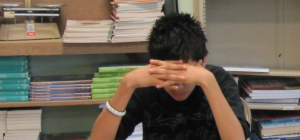Drop-out numbers provide more evidence for the U.S. achievement gap when broken down, and hidden in those numbers is a Dreamer fact that seems to escape many of our nation’s leaders. Our schools are teaching Dreamer children, the sons and daughters of undocumented workers facing an uncertain future. These children, like all children, only bring so much hope and resilience into the classroom. The amounts vary. Some kids can ignore the reality of their daily lives almost completely while happily planning to be part of the first Martian colony. Others take more prosaic views of their lives, however, and believe what older siblings and adults tell them.
“You can’t be a nurse. You don’t have a social,” big brother says. (Short for social security number.)
“You can’t be a teacher. They are going to make us go back to Guatemala anyway,” big sister says.
That “social” is an especially big deal. Without that magic number, many occupations are effectively closed to Dreamer children. Factory or yardwork jobs are possible, but any position that requires a background check is pretty much off-limits. Almost all college loans require that social, too, although a number of colleges and universities are running their own loan programs.
Dreamer children easily lose hope, and often at a young age. I have watched many slip away from me in middle school, using their Dreamer status as a reason and sometimes an excuse for the studying that never happens and work that never gets turned in. Giving adolescents an excuse not to work will always be a loser. Giving them no reason to dream is criminal.
The Hispanic dropout rate always comes in highest when we look at government charts, despite the fact that many of these children come from intact families with a solid work ethic. Mom and dad may be working three or four jobs between the two of them. For the year 2015, the U.S. government estimates 4.6% of whites dropped out of high school, 6.5% of blacks, and 9.2% of Hispanics.*
We might pause to congratulate ourselves that the gap between whites and African-Americans stood at only 1.9 percentage points in 2015, down from 6.2 percent points in 2000. But if we want to see a similar narrowing of the gap between our Nonhispanic White and Hispanic students, we will have to address the challenge of those Dreamer children, the ones who do not see the point in finishing high school because they don’t believe 1) that they can afford college and 2) that college will allow them to realize the dreams they once had, before a realistic friend or family member explained how that “social” number worked.
*https://nces.ed.gov/programs/digest/d16/tables/dt16_219.70.asp?current=yes See also https://nces.ed.gov/fastfacts/display.asp?id=16

